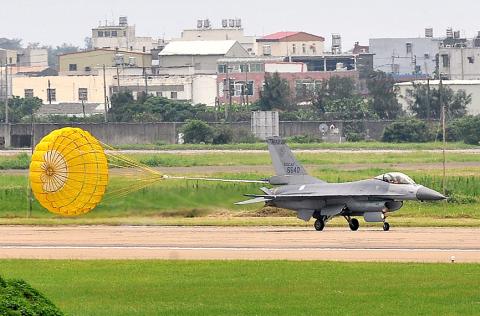The air force will procure the full US$5.2 billion upgrade package for its fleet of F-16A/B fighter jets notified to the US Congress in September last year, but will do so in two phases, the Taipei Times has learned.
This latest twist in the F-16 saga comes after reports in February said that the Executive Yuan had decided it would give the air force only US$3.7 billion to upgrade its 145 F-16A/Bs, forcing the military to trim some of the articles included in the US$5.2 billion package, which includes Active Electronically Scanned Array (AESA) radars, electronic warfare suites, air-to-air missiles and, more controversially, a variety of Joint Direct Attack Munitions (JDAM) kits.
Air Force Command Headquarters announced early last month that it had received an official answer from the US, which reportedly contained articles that reflected the US$3.7 billion allocated by the Executive Yuan.

Photo: Chien Jung-fong, Taipei Times
Taiwan is currently evaluating the contents of the letter and is expected to sign the letter of agreement within 45 to 60 days.
However, a defense industry source told the Taipei Times yesterday that Taiwan would still procure the entire US$5.2 billion upgrade, but would do so in two phases, with the second phase — worth about US$1.5 billion — taking place in two years.
Because the full package has already been notified, no second notification will be necessary for Taiwan to submit a letter of agreement for the second phase, the source said.
The electronic warfare suite is being specifically designed for Taiwan and will not be ready until 2016 or early 2017, the source said, adding that the development cost for the system is part of the retrofit package. The same suite would be installed on the F-16C/Ds that Taiwan has been seeking since 2006.

ANOTHER EMERGES: The CWA yesterday said this year’s fourth storm of the typhoon season had formed in the South China Sea, but was not expected to affect Taiwan Tropical Storm Gaemi has intensified slightly as it heads toward Taiwan, where it is expected to affect the country in the coming days, the Central Weather Administration (CWA) said yesterday. As of 8am yesterday, the 120km-radius storm was 800km southeast of Oluanpi (鵝鑾鼻), Taiwan’s southernmost tip, moving at 9kph northwest, the agency said. A sea warning for Gaemi could be issued tonight at the earliest, it said, adding that the storm is projected to be closest to Taiwan on Wednesday or Thursday. Gaemi’s potential effect on Taiwan remains unclear, as that would depend on its direction, radius and intensity, forecasters said. Former Weather Forecast

As COVID-19 cases in Japan have been increasing for 10 consecutive weeks, people should get vaccinated before visiting the nation, the Centers for Disease Control (CDC) said. The centers reported 773 hospitalizations and 124 deaths related to COVID-19 in Taiwan last week. CDC Epidemic Intelligence Center Director Guo Hung-wei (郭宏偉) on Tuesday said the number of weekly COVID-19 cases reported in Japan has been increasing since mid-May and surpassed 55,000 cases from July 8 to July 14. The average number of COVID-19 patients at Japan’s healthcare facilities that week was also 1.39 times that of the week before and KP.3 is the dominant

The Chinese Communist Party’s (CCP) working group for Taiwan-related policies is likely to be upgraded to a committee-level body, a report commissioned by the Mainland Affairs Council (MAC) said. As Chinese President Xi Jinping (習近平) is increasingly likely to upgrade the CCP’s Central Leading Group for Taiwan Affairs, Taiwanese authorities should prepare by researching Xi and the CCP, the report said. At the third plenary session of the 20th Central Committee of the CCP, which ended on Thursday last week, the party set a target of 2029 for the completion of some tasks, meaning that Xi is likely preparing to

US-CHINA TRADE DISPUTE: Despite Beijing’s offer of preferential treatment, the lure of China has dimmed as Taiwanese and international investors move out Japan and the US have become the favored destinations for Taiwanese graduates as China’s attraction has waned over the years, the Ministry of Labor said. According to the ministry’s latest income and employment advisory published this month, 3,215 Taiwanese university graduates from the class of 2020 went to Japan, surpassing for the first time the 2,881 graduates who went to China. A total of 2,300 graduates from the class of 2021 went to the US, compared with the 2,262 who went to China, the document showed. The trend continued for the class of 2023, of whom 1,460 went to Japan, 1,334 went to